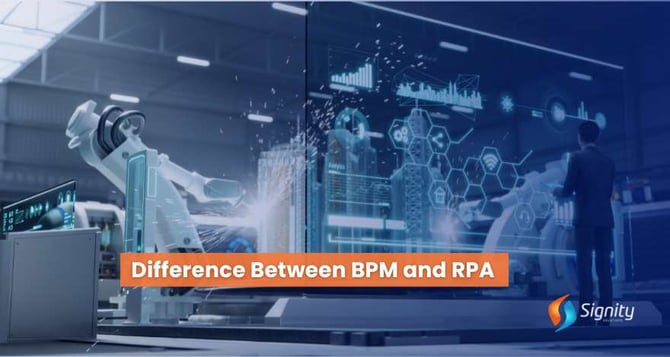Understanding the Difference Between BPM and RPA
Discover how integrating Business Process Management (BPM) and Robotic Process Automation (RPA) can revolutionize your organization's efficiency. Learn about their distinct functionalities, synergies, and how our AI-powered solutions optimize their integration for unparalleled operational excellence.

Two powerful methodologies stand out in business process optimization: BPM (Business Process Management) and RPA (Robotic Process Automation). Although both are geared towards enhancing efficiency and streamlining operations, they embody unique approaches with distinct functionalities.
Discerning the disparity between BPM and RPA is paramount for organizations aiming to leverage automation effectively. Let's embark on a journey to dissect each concept, elucidating their disparities and respective benefits.
Business Process Management (BPM)
BPM epitomizes a holistic approach to managing and enhancing business processes across an organization. It encompasses a spectrum of activities, including analysis, design, implementation, monitoring, and continuous workflow optimization, all of which aim to achieve organizational goals.
The focal point of BPM lies in optimizing processes for efficiency, agility, and effectiveness while ensuring alignment with business objectives and customer needs.
Key Characteristics of BPM:
-
Process-Centric Approach: BPM underscores the importance of viewing operations as interconnected processes rather than isolated tasks. It involves mapping out end-to-end workflows, identifying bottlenecks, and optimizing processes for maximum efficiency.
-
Human-Centric: BPM typically integrates human intervention at various stages of the process, encompassing manual tasks, decision-making, and collaborative efforts among employees.
-
Process Modeling and Analysis: BPM leverages modelling techniques such as process flowcharts, swimlane diagrams, and BPMN (Business Process Modeling Notation) to visualize and analyze workflows. This enables stakeholders to comprehend process dependencies, pinpoint improvement opportunities, and simulate changes before implementation.
-
Continuous Improvement: BPM embodies an iterative process focused on continuous enhancement. Organizations consistently review and refine their processes based on feedback, performance metrics, and evolving business requirements.
Explore the Power of RPA Integration
Dive into RPA's capabilities and see a 40% reduction in processing time firsthand. Our AI expertise ensures seamless integration.
Robotic Process Automation (RPA)
RPA entails using software robots or "bots" to automate repetitive, rule-based tasks that were previously executed by humans. These bots mimic human actions by interacting with applications, manipulating data, and making decisions based on predefined rules. RPA proves particularly effective in automating high-volume, routine tasks across diverse systems and applications.
Key Characteristics of RPA:
-
Task Automation: RPA specializes in automating repetitive, rule-based tasks that are well-defined and predictable. These tasks often include data entry, extraction, manipulation, and transaction processing.
-
Software Robots: RPA bots function by interfacing with user interfaces and APIs (Application Programming Interfaces) akin to humans. They navigate through various systems, input data, perform calculations, and trigger actions without necessitating complex integrations or modifications to existing IT infrastructure.
-
Speed and Accuracy: RPA bots exhibit remarkable speed and accuracy in task execution, substantially diminishing processing times and error rates compared to manual execution.
-
Scalability and Flexibility: RPA solutions boast high scalability and adaptability to evolving business needs. Organizations can deploy multiple bots to manage escalating workloads or swiftly modify existing processes without extensive coding or development endeavours.
Key Differences and Complementary Nature
Despite their shared objective of enhancing operational efficiency, BPM and RPA diverge in scope, approach, and implementation:
-
Scope: BPM targets the optimization of end-to-end business processes across an organization, encompassing both automated and manual tasks. In contrast, RPA focuses on automating specific tasks or activities within processes using software robots.
-
Approach: BPM emphasizes process analysis, design, and optimization, often involving human collaboration and decision-making. On the flip side, RPA concentrates on task automation through software robots, necessitating minimal human intervention post-deployment.
-
Implementation: BPM initiatives typically entail process redesign, organizational change management, and integration with existing IT systems. Conversely, RPA implementations are more lightweight and can be swiftly deployed without extensive alterations to underlying infrastructure or business processes.
Despite these disparities, BPM and RPA are complementary methodologies that can be seamlessly integrated to yield synergistic benefits. Organizations can harness BPM to pinpoint automation opportunities, prioritize tasks for RPA implementation, and monitor automation's impact on overall process performance.
By amalgamating BPM's process optimization prowess with RPA's task automation capabilities, organizations can attain heightened operational efficiency, agility, and competitiveness in today's dynamic business landscape.
How Our Company Enhances BPM and RPA Integration
As a leading robotic process automation company, we specialize in leveraging cutting-edge AI technologies to augment our clients' BPM and RPA integration.
Transform Your Business with AI Integration
Discover how our AI-powered solutions, integrating BPM and RPA, can boost efficiency by up to 50% according to industry statistics.
Our team of seasoned experts employs advanced AI algorithms and machine learning techniques to analyze existing processes, identify automation opportunities, and design bespoke solutions tailored to your organizational needs.
Whether you seek to streamline workflows, optimize resource utilization, or enhance decision-making capabilities, our AI-powered solutions empower you to unlock the full potential of BPM and RPA synergy. Partner with us to embark on a transformative journey towards operational excellence and sustainable growth.


%201-1.webp?width=148&height=74&name=our%20work%20(2)%201-1.webp)


.png?width=344&height=101&name=Mask%20group%20(5).png)

















